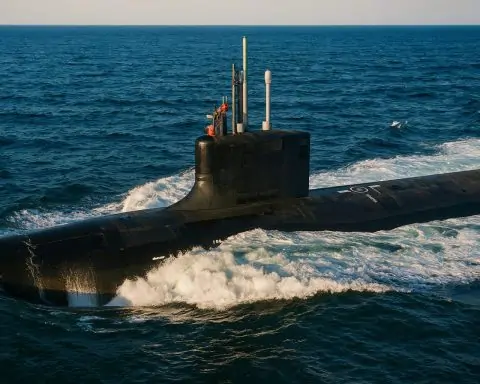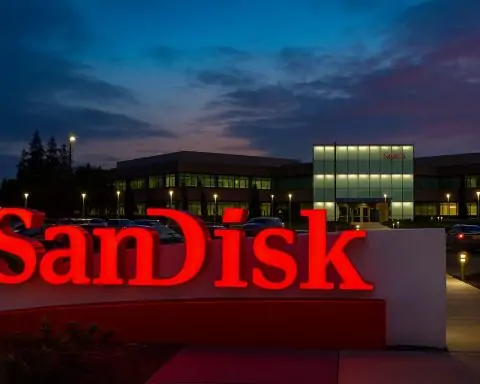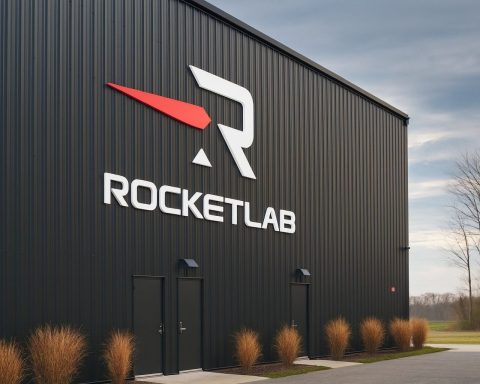SpaceX Sets Launch Records, Amazon’s Kuiper Mission Up Next
- Starlink Launch Frenzy: SpaceX lofted 28 more Starlink internet satellites from Florida in the pre-dawn hours of Aug. 4, marking the company’s 96th Falcon 9 launch of 2025 [1]. The veteran booster (serial B1080) completed its 21st flight and landed on a drone ship, underscoring SpaceX’s rapid reusability strides [2]. With launches now coming every ~2.5 days, Elon Musk’s team is on pace to shatter annual launch records [3]. (Fifteen of B1080’s missions have been Starlink flights [4], highlighting how SpaceX’s in-house constellation dominates its manifest.)
- Amazon’s Kuiper to Launch: SpaceX is now gearing up to launch Amazon’s Project Kuiper satellites this week. A Falcon 9 is slated to lift 24 Kuiper broadband satellites on Thursday, Aug. 7 from Cape Canaveral (with a backup window on Friday) [5]. This “KF-02” mission is the second launch for Amazon’s planned low-Earth orbit internet megaconstellation. SpaceX reports an 85% chance of favorable weather for Thursday’s attempt [6]. The booster (on its first flight for this mission) will attempt to land on the A Shortfall of Gravitas droneship post-launch [7].
Rocket Lab Delivers Japanese Radar Satellite
- Successful Electron Launch: U.S.–New Zealand company Rocket Lab notched another orbital success on Aug. 5. An Electron rocket launched the mission whimsically named “The Harvest Goddess Thrives,” carrying a synthetic-aperture radar satellite for Japanese firm iQPS [8]. Liftoff from Rocket Lab’s New Zealand pad occurred at 12:10 a.m. ET on Aug. 5 (4:10 p.m. local time), and the QPS-SAR-12 satellite (nicknamed Kushinada-I) was deployed into a 575 km circular orbit about 54 minutes later [9]. The satellite will join iQPS’s growing constellation of SAR imaging spacecraft, which aim to provide high-resolution all-weather, day-night Earth observations [10]. Rocket Lab noted the data from this radar fleet has potential to “revolutionize industries” by enabling insights for agriculture, urban security, and more [11]. This launch was Rocket Lab’s second in just a week, reflecting a quickened cadence as the company strives to increase its market share in small satellite launches.
China Launches Internet Satellites, Sparks Debris Concerns
- Long March 12 Advances ‘Chinese Starlink’: On Aug. 4 (Monday night Beijing time), China’s new Long March 12 rocket conducted its second flight, launching the 7th batch of low-Earth-orbit “internet satellites” for China’s planned broadband megaconstellation [12] [13]. The two-stage Long March 12 lifted off from a commercial launch site on Hainan Island at 6:21 p.m. local, successfully inserting the satellite group into their preset orbit [14]. Chinese state media noted the rocket can haul 12+ tons to LEO and that this was the 587th mission in the Long March series [15] [16]. The rapid reuse and flight turnaround of Long March 12 (which debuted in Nov 2024) signals China’s push to deploy a large-scale internet constellation akin to SpaceX’s Starlink [17] [18]. Beijing’s strategic goal is to enhance global connectivity and reduce reliance on foreign satellite networks [19], with the Guowang constellation poised to offer high-speed, low-latency internet worldwide [20].
- Philippines Protests Falling Rocket Debris: The Philippine government condemned this Chinese launch after suspected rocket debris fell near Palawan province, causing alarm [21] [22]. Residents reported loud explosions and a fireball in the sky Monday night as parts of the Long March rocket’s booster plummeted into the Sulu Sea off Palawan [23]. “We condemn in no uncertain terms the irresponsible testing… of the Long March 12 rocket which alarmed the public and placed people at risk,” said Philippines National Security Adviser Eduardo Año [24]. No injuries were reported, but officials warned the discarded booster and fairing posed a “clear danger” to ships, aircraft and fishing vessels in the drop zones [25] [26]. The Philippine Space Agency had issued notices of two offshore drop areas (~35–40 km from Palawan) prior to the launch [27], but it’s unclear if China gave formal advance warning [28]. Philippine forces are now searching for debris, and the incident has renewed calls for responsible space launch practices, as unannounced debris fall can endanger lives and property [29] [30].
NASA Mission Updates: Small-Sat Setbacks & Mars Rover Milestone
- Lunar Trailblazer Declared Lost: NASA has formally ended the Lunar Trailblazer mission, a small Moon-orbiting cubesat that fell silent shortly after launch. The $94 million craft launched Feb. 26 but lost contact a day later, never completing its planned water-mapping of the Moon [31]. After months of recovery attempts, NASA announced on July 31 that the mission is considered unrecoverable [32]. Despite the failure, officials defended the effort as a learning experience. “At NASA, we undertake high-risk, high-reward missions like Lunar Trailblazer… While it was not the outcome we had hoped for, mission experiences like [this] help us to learn and reduce the risk for future low-cost small satellites,” said NASA science chief Nicky Fox in a statement praising the team’s dedication through the end [33].
- New Small Satellite Challenges: Problems have also emerged with other recently launched NASA small sats. Athena EPIC, a small experimental satellite deployed on July 23 via a SpaceX Falcon 9, has yet to send its expected beacon signal [34]. NASA and industry partner NovaWurks are working from a California ops center to hail the suitcase-sized sat on each orbital pass, investigating faint signals to confirm its orbit and status [35] [36]. Teams are diagnosing why the initial signal was missed and attempting to establish communications. Meanwhile, one of NASA’s new twin TRACERS satellites – launched July 23 to study Earth’s magnetic field – suffered a power system glitch. “Space Vehicle 1” (SV1) experienced a power subsystem issue on July 25 that led to intermittent contacts and then loss of communication [37]. Data suggest SV1 can only power on when its solar panels get sufficient sunlight, so the satellite is likely stuck in a low-power state [38]. Due to its current orientation, the next chance to reestablish contact will be later in August when SV1’s panels receive more sunlight [39]. Until then, the TRACERS team is analyzing telemetry to pinpoint the fault. Fortunately, the second TRACERS spacecraft (SV2) is healthy – it has begun commissioning and is on track to complete checkouts by the end of August [40]. The TRACERS mission aims to explore how solar activity drives magnetic reconnection in Earth’s magnetosphere [41], and NASA will provide further status updates in the coming weeks.
- Mars Rover Turns 13 with New Tricks: On Mars, NASA’s hardy Curiosity rover just hit 13 years of operations (having landed in August 2012) and is still learning new tricks. Engineers recently beamed up a software upgrade enabling Curiosity to multitask and conserve power more efficiently, allowing the rover to drive, take photos, and relay data to orbiters simultaneously instead of sequentially [42]. By squeezing more activity into each Martian day, this update maximizes science output from the rover’s aging plutonium battery [43]. “It’s as if our teenage rover is maturing, and we’re trusting it to take on more responsibility,” quipped JPL engineer Reidar Larsen, noting the team has become less like “cautious parents” and now lets the rover decide when to pause or work [44]. Thanks to these tweaks, Curiosity has “ample power” to keep climbing Mount Sharp in search of past habitable environments [45]. The rover recently drove through intriguing mineral-rich ridges that suggest water persisted on ancient Mars longer than previously thought [46]. As Curiosity soldiers on past Sol 4600, it even imaged a strange coral-like rock formation – likely sculpted by eons of wind and water – underscoring that Mars still holds geologic surprises [47]. NASA is also looking ahead to crewed exploration: acting Administrator Sean Duffy reminded this week that Artemis II is only about six months out. “In about six months, Artemis II astronauts will journey around the Moon for the first time in 53 years,” Duffy noted, adding that the crew carries “the pride, power, and promise” of America’s return to deep space [48]. The four Artemis II astronauts are in intensive training for that late-2025 mission, which will be the first to send humans around the Moon since Apollo 17 in 1972.
ISS Crew Rotation and U.S.-Russia Cooperation
- Crowded House in Orbit: The International Space Station is briefly standing-room-only. SpaceX’s Crew-11 mission arrived at the ISS on Saturday (Aug. 2), bringing 4 new crew members – NASA astronauts Zena Cardman and Mike Fincke, JAXA astronaut Kimiya Yui, and Roscosmos cosmonaut Oleg Platonov [49]. Their Crew Dragon Endurance docked successfully, bumping the orbiting headcount to 11 people on board [50] – an eclectic, multi-national mix that will persist until the prior crew departs. The newcomers spent their first days in orbit unpacking supplies, getting oriented, and reviewing safety procedures [51]. They’ll soon dive into a busy research agenda featuring experiments that leverage microgravity – from growing stem cells and testing plant growth, to trying antibiotic alternatives – work that could advance medicine and agriculture back on Earth [52] [53]. The ISS residents have also begun an orbital “handover”: the four outgoing Crew-10 members (NASA’s Anne McClain and Nichole Ayers, JAXA’s Takuya Onishi, and Roscosmos’s Kirill Peskov) have been mentoring Crew-11 and will transfer responsibilities before returning to Earth later this week [54]. The Crew-10 astronauts have spent ~5 months in orbit conducting over 200 science experiments, including studies of how long-duration spaceflight affects the human body and tests of lunar navigation tech for Artemis [55] [56]. They were originally scheduled to undock on Aug. 6, but NASA delayed departure due to unfavorable splashdown weather [57]. Undocking is now targeted for Thursday morning (Aug. 7), with the Crew-10 Dragon capsule set to reenter and splash down off the Florida coast on Friday, Aug. 8 [58] [59]. “I’m reflecting with a heart full of gratitude,” pilot Nichole Ayers said of her mission, calling the experience “amazing” and full of “big belly laughs” and camaraderie in orbit [60] [61].
- NASA and Roscosmos Talk Partnership: In a notable diplomatic meeting, the heads of NASA and Russia’s space agency met face-to-face on U.S. soil – the first such encounter in nearly 7 years [62]. NASA’s new acting Administrator Sean Duffy sat down with Dmitry Bakanov, Director General of Roscosmos, at Kennedy Space Center last weekend as the Crew-11 launch was underway [63]. Roscosmos publicized the meeting with video footage, calling it a milestone dialogue. According to the Russian side, “the parties discussed further work on the ISS, cooperation on lunar programs, joint exploration of deep space, [and] continued interaction on other space projects” [64]. NASA’s public statement was far more muted – merely noting that the chiefs “discussed continued cooperation and collaboration in space,” without elaborating [65]. Still, the symbolism is significant: even amid geopolitical strains on Earth, Washington and Moscow are keeping communication channels open in orbit. The timing of the meeting – coinciding with a high-profile crew launch carrying both NASA and Roscosmos personnel – highlighted the two agencies’ interdependence on the ISS [66]. In fact, NASA and Roscosmos recently extended their ISS “seat-swap” agreement through 2027, ensuring U.S. astronauts and Russian cosmonauts will continue riding each other’s spacecraft in mixed crews [67]. This arrangement helps maintain redundant access to orbit for both sides and signals mutual commitment to the station’s final years. Space analysts observed that Roscosmos was eager to tout the cordial meeting, while NASA kept a low profile – a contrast that “speaks volumes” [68]. Nonetheless, the enduring space partnership appears intact. As one industry observer put it, this brief rendezvous is a reassuring sign that “space cooperation endures” despite terrestrial tensions [69].
Europe Preps Ariane 6 Debut and Future Missions
- Ariane 6 Ready for Maiden Flight: Europe is counting down to a major launch milestone: the first flight of the new Ariane 6 rocket. At Europe’s Spaceport in Kourou, French Guiana, engineers have now encapsulated the first MetOp-SG weather satellite into the Ariane 6’s payload fairing, signaling final preparations for launch [70] [71]. The satellite, MetOp-SG-A1, is an advanced polar-orbiting meteorological satellite and carries the first Copernicus Sentinel-5 atmospheric sensor instrument [72] [73]. It’s scheduled to lift off on 13 August at 02:37 CEST (Aug. 12, 21:37 local time in Kourou) [74]. This mission inaugurates the MetOp Second Generation series, a collaborative program between ESA and Eumetsat to provide improved global weather observations for the next 20+ years [75] [76]. For the team that has spent over a decade on MetOp-SG’s development, sealing the satellite inside the rocket was an emotional moment. “None of us will actually see the satellite [again] – the fairing will not be opened until 3 minutes 30 seconds after liftoff,” noted ESA project manager Marc Loiselet, who has worked on the mission since 2012 [77]. Now under the protective fairing, MetOp-SG-A1’s environment is being monitored as excitement builds for the historic Ariane 6 inaugural launch next week [78].
- Exoplanet Hunter Passes Design Review: The European Space Agency reached a key milestone for its upcoming exoplanet mission PLATO (Planetary Transits and Oscillations of Stars). ESA approved the final design of the PLATO space telescope, clearing the mission to proceed into full development [79]. PLATO, slated to launch in 2026, will be a groundbreaking planet-hunter – it carries 26 identical cameras and telescopes that will monitor hundreds of thousands of relatively nearby stars for the faint dimming signals of orbiting exoplanets [80]. The goal is to discover and study “tens of thousands of Earth-like exoplanets” around Sun-like stars, including planets in the habitable zone [81]. By measuring tiny, regular dips in starlight when planets transit, PLATO will help identify rocky, Earth-sized worlds and assess their properties. The mission will also perform asteroseismology (studying starquakes) on target stars to precisely determine each host star’s mass, age, and size – crucial data for evaluating the planets’ characteristics [82] [83]. Researchers at KU Leuven and the University of Liège in Belgium (among many European institutes) are deeply involved in building and testing PLATO’s camera systems [84] [85]. With the design phase now successfully concluded after years of work, hardware manufacturing and integration will ramp up. Science teams are eagerly anticipating PLATO’s haul of new worlds; as Belgium’s lead scientist Prof. Conny Aerts – who has worked on PLATO for over a decade – said of this step forward: “At the time [PLATO was proposed], it was my dream to work with PLATO data before my retirement. That’ll be a tight deadline…” [86].
- Robotic Avatar Demo: In technology news, a remarkable ESA–DLR experiment brought us closer to future human–robot planetary exploration. During the Surface Avatar tests last week, an astronaut aboard the ISS remotely controlled two robots in Germany through complex tasks on a Mars-like terrain [87]. This real-time telerobotics demo had one rover performing delicate operations (like collecting samples) while a humanoid robot assisted – all directed by commands from space [88]. The exercise tested advanced control interfaces and feedback systems that would allow astronauts orbiting the Moon or Mars to effectively “teleoperate” rovers on the surface below. Early results were positive, showcasing how crew in orbit could safely conduct surface exploration via robotic avatars. European scientists hailed the experiment as a major step toward integrating human and robotic missions – for example, an astronaut around Mars could use robotic proxies to explore hazardous areas in near-real time, combining human intuition with machine endurance. This project is part of Europe’s push to develop remote operation capabilities for future Lunar Gateway and Mars missions, ensuring astronauts can extend their reach beyond their immediate habitats [89].
Big Commercial Deals: Smartphone Constellations & Moon Ventures
- $5 Billion Smartphone Satellite Constellation: A blockbuster industry deal this week will kick-start a new low-orbit satellite network for direct-to-phone service. U.S. operator EchoStar announced it has selected Canada’s MDA Ltd. to manufacture up to 200 broadband satellites for EchoStar’s next-generation constellation [90]. The plan is to beam 5G broadband and texting directly to ordinary mobile phones (no special dish needed) using S-band satellite spectrum rights that EchoStar holds [91]. The companies signed an initial $1.3 billion contract for the first 100 satellites – MDA’s new “Aurora” software-defined smallsat model – with options to build 100 more [92] [93]. If all options are exercised, the project’s cost is estimated around $5 billion [94], making it one of the priciest commercial space ventures in years. EchoStar (traditionally a geostationary TV satellite operator) is boldly pivoting into the direct-to-device market, aiming to eliminate cellular dead zones globally by 2029 [95] [96]. “Our satellite expertise combined with our terrestrial 5G network uniquely positions EchoStar to execute on this wideband LEO constellation,” said CEO Hamid Akhavan, touting the deal as a win for U.S. leadership in space-based telecom [97]. Production of the first batch begins immediately, with MDA expecting to feed satellites into its assembly lines by Q3 2025 and initial launches by the late 2020s [98]. Industry analysts note this move makes EchoStar the anchor customer for MDA’s new LEO satellite platform and marks MDA’s fourth major constellation contract in just three years – a sign of booming demand for satellite manufacturing capacity [99]. The news sent ripples through the sector as firms race to claim slices of the sky for direct-to-phone and IoT communications. EchoStar’s leap puts it in competition with SpaceX (which is teaming with T-Mobile for Starlink-to-cell service) and startups like AST SpaceMobile. It underscores that satellite-to-smartphone connectivity is seen as a lucrative frontier – with billions on the line, companies are betting that in the near future consumers will use satellite links as seamlessly as cell towers.
- AST SpaceMobile Launch Delayed: In related news, AST SpaceMobile – one of the upstart players in satellite-direct-to-phone – is facing continued delays for its first large satellite launch. AST’s prototype BlueBird satellite (also called BlueWalker 3 FM1), a massive 6,500 kg spacecraft, was slated to launch on India’s LVM3 rocket this summer [100]. The launch slipped from June to July to August, and now officials say the satellite won’t be ready to fly until at least September [101] [102]. ISRO Chairman Dr. V. Narayanan confirmed the satellite missed its shipment date by three months due to “developmental issues” [103]. The latest plan expects the spacecraft to arrive at India’s launch site in September, after which it will require 20–30 days of routine prep – meaning an October launch is likely [104] [105]. AST SpaceMobile’s satellite is unusually heavy (over 6 tons) because it reportedly carries an extra payload for a U.S. government customer [106] [107]. The delay raises questions about schedule coordination, as ISRO must decide whether to keep an LVM3 rocket idling for AST or reassign it to another mission if the wait drags on [108]. Investors are watching closely: AST is due to provide an update in its quarterly report on August 11 [109]. The mission’s slip to Q4 could impact AST’s plans to start offering initial space-based cellular service. (Notably, AST did deploy an earlier test satellite, BlueWalker 3, which unfolded a record-setting antenna in orbit last year; the upcoming FM1 is expected to be the first operational satellite in its planned constellation.) The direct-to-mobile space race is clearly heating up, with both established operators like EchoStar and newer entrants like AST vying to connect phones from space.
- Firefly’s Moon Contract and IPO Lift-Off: Texas-based launch and lunar lander company Firefly Aerospace is having a banner week – scoring a major NASA Moon contract and edging closer to a huge IPO. NASA announced it has awarded Firefly a $176.7 million contract under the CLPS program (Commercial Lunar Payload Services) to deliver five science payloads to the Moon’s south pole in 2029 [110]. Dubbed Blue Ghost Mission 4, this flight will use Firefly’s new Elytra orbital transfer vehicle and a Blue Ghost lander to carry two small rovers (one for NASA, one for the Canadian Space Agency) plus three science instruments to the lunar surface [111]. The payloads will investigate vital resources and conditions in the permanently shadowed craters – mapping ice deposits, and measuring radiation and temperature – to help pave the way for Artemis astronauts [112]. The lander is expected to operate for 12+ days as a base station for the rovers hunting water ice [113]. This win cements Firefly’s status in NASA’s fast-track Moon delivery initiative. Notably, Firefly already pulled off a lunar feat earlier this year: in March, its Blue Ghost Mission 1 successfully soft-landed on the Moon, making Firefly only the second private firm ever to achieve a lunar landing (and the first to do so successfully on the initial try) [114]. Riding that momentum, Firefly is moving forward with an initial public offering. On Aug. 4, the company updated its SEC filings to raise its target share price to $41–$43, aiming for a valuation just over $6 billion [115]. At that range, Firefly would sell ~16.2 million shares to raise about $697 million in fresh capital [116]. This is a hefty jump from the ~$2 billion valuation Firefly had last year [117], reflecting surging investor confidence. One IPO analyst noted the narrowed price band “signals well-covered books on high demand and strong pricing conviction after a positive roadshow” [118] – in other words, investors are clamoring for a piece of the space boom. Indeed, Firefly’s offering is shaping up to be one of the largest pure-play space listings to date. With strategic backing from Northrop Grumman and its recent lunar exploits, Firefly appears to have convinced markets that it’s a serious contender. “Investor appetite for space is back in orbit,” one market watcher said, crediting high-profile successes like Firefly’s and renewed government focus on space tech for reviving enthusiasm [119]. Firefly’s IPO, expected imminently, will be a bellwether for the NewSpace sector’s ability to attract public capital amid broader economic headwinds.
- Satellite Surveillance Tech: Elsewhere in the industry, two defense-oriented startups are teaming up on next-gen orbital sensors. Eoptic and Starris announced a strategic partnership to co-develop multispectral imaging payloads for satellites [120]. By combining Eoptic’s advanced UV–visible–IR sensor technology with Starris’s precision optics, the duo aims to build compact space cameras capable of spotting “previously undetectable” events – for example, the distinctive flash or exhaust plume of a hypersonic missile launch – from orbit [121]. “This collaboration…is a game-changer for space domain awareness and defense applications,” said Eoptic CEO Pano Spiliotis, noting the ability to track elusive high-speed targets in real time from space [122]. The first joint system is already in development, focused on hypersonic vehicle detection for U.S. defense customers [123]. This partnership reflects growing interest in using commercial satellites for national security surveillance, as countries seek more eyes in the sky to monitor emerging threats. With hypersonic missiles presenting a challenge for traditional ground-based radar, new space-based sensing solutions like this could significantly enhance early warning and tracking. It’s also an example of startups innovating niche technologies that may feed into larger constellations for military or civil use. Analysts say to expect more such alliances as the demand for specialized Earth observation and space situational awareness data continues to rise [124] [125].
Space Policy Highlights: Nuclear Power in the Moon Race
- NASA Pushes Lunar Nuclear Plant: In policy news, NASA’s leadership is embracing nuclear power to secure America’s foothold on the Moon. Acting NASA Administrator Sean Duffy made waves with remarks that the United States is “in a race with China to the Moon” and must establish a sustained base at the lunar south pole – including deploying a 100-kilowatt fission reactor for power [126] [127]. In a directive issued late July, Duffy ordered NASA to accelerate development of a lunar Fission Surface Power system, upping the target output from earlier 10 kW and 40 kW concepts to a full 100 kW reactor [128] [129]. Such a reactor could provide reliable energy through the two-week-long lunar nights, a capability solar panels and batteries alone struggle to achieve. Duffy argues this is critical for a permanent Moon base: “To have a base on the Moon, we need energy… this fission technology is critically important,” he said, noting NASA has studied the idea for years and now needs to move from research to deployment [130]. The lunar south pole is coveted because of its near-continuous sunlight in some areas and potential ice deposits in eternally dark craters – resources both the U.S. and China are eyeing. Duffy stirred controversy by adding that “there’s a certain part of the Moon that everyone knows is the best and we want to get there first and claim that for America” [131]. The phrasing raised eyebrows, since the 1967 Outer Space Treaty forbids national appropriation of celestial territory [132]. NASA later clarified that Duffy meant the U.S. should “claim” leadership and presence at the prime locations, not sovereignty [133]. Still, the rhetoric underscores an increasingly competitive backdrop as China advances its Chang’e lunar program. Duffy’s dual role as Acting NASA Administrator and U.S. Transportation Secretary (a unique arrangement after the previous nominee for NASA chief withdrew) also brought extra attention to his statements [134]. In Congress, lawmakers have noticed: the chairs of NASA’s House and Senate oversight committees wrote to Duffy on Aug. 5 asking how he plans to spend the $10 billion in new NASA funds provided by last month’s budget legislation – implicitly questioning whether initiatives like the lunar reactor will fit into that budget [135]. Duffy’s response and strategy for the Moon race will likely come under further scrutiny in upcoming hearings. For now, NASA and the Department of Energy are pressing ahead on fission power prototypes, aiming to demonstrate a unit on the Moon by the late 2020s as part of the Artemis infrastructure [136] [137]. Space policy experts note that while international cooperation in space is important, there is undeniably a new Space Race vibe – not about flags and footprints, but about whose tech and industry will dominate future lunar and Mars economies. The U.S. is signalling it doesn’t intend to cede leadership on the final frontier, be it through nuclear-powered bases or diplomatic frameworks like the Artemis Accords [138].
Sources: Space.com; SpaceNews; NASA Press Releases and Blogs; Reuters; Associated Press; ESA; TS2 Space Roundup; SatNews; Advanced Television; Qazinform [139] [140] [141] [142] [143] [144] [145] [146] [147] [148] [149] [150] [151] [152] [153] [154] [155].
References
1. ts2.tech, 2. ts2.tech, 3. ts2.tech, 4. ts2.tech, 5. news.satnews.com, 6. news.satnews.com, 7. news.satnews.com, 8. www.space.com, 9. www.space.com, 10. www.space.com, 11. www.space.com, 12. abcnews.go.com, 13. ts2.tech, 14. abcnews.go.com, 15. abcnews.go.com, 16. ts2.tech, 17. dailygalaxy.com, 18. dailygalaxy.com, 19. dailygalaxy.com, 20. dailygalaxy.com, 21. abcnews.go.com, 22. abcnews.go.com, 23. abcnews.go.com, 24. abcnews.go.com, 25. abcnews.go.com, 26. abcnews.go.com, 27. abcnews.go.com, 28. abcnews.go.com, 29. abcnews.go.com, 30. abcnews.go.com, 31. ts2.tech, 32. ts2.tech, 33. ts2.tech, 34. www.nasa.gov, 35. www.nasa.gov, 36. www.nasa.gov, 37. science.nasa.gov, 38. science.nasa.gov, 39. science.nasa.gov, 40. science.nasa.gov, 41. science.nasa.gov, 42. ts2.tech, 43. ts2.tech, 44. ts2.tech, 45. ts2.tech, 46. ts2.tech, 47. ts2.tech, 48. ts2.tech, 49. ts2.tech, 50. ts2.tech, 51. ts2.tech, 52. ts2.tech, 53. ts2.tech, 54. ts2.tech, 55. www.cfpublic.org, 56. www.cfpublic.org, 57. www.cfpublic.org, 58. www.cfpublic.org, 59. www.cfpublic.org, 60. www.cfpublic.org, 61. www.cfpublic.org, 62. ts2.tech, 63. ts2.tech, 64. ts2.tech, 65. ts2.tech, 66. ts2.tech, 67. ts2.tech, 68. ts2.tech, 69. ts2.tech, 70. www.esa.int, 71. www.esa.int, 72. www.esa.int, 73. www.esa.int, 74. www.esa.int, 75. www.esa.int, 76. www.esa.int, 77. www.esa.int, 78. www.esa.int, 79. www.electronicspecifier.com, 80. www.electronicspecifier.com, 81. www.electronicspecifier.com, 82. www.electronicspecifier.com, 83. www.electronicspecifier.com, 84. www.electronicspecifier.com, 85. www.electronicspecifier.com, 86. www.electronicspecifier.com, 87. ts2.tech, 88. ts2.tech, 89. ts2.tech, 90. ts2.tech, 91. ts2.tech, 92. ts2.tech, 93. ts2.tech, 94. ts2.tech, 95. ts2.tech, 96. ts2.tech, 97. ts2.tech, 98. ts2.tech, 99. ts2.tech, 100. www.advanced-television.com, 101. www.advanced-television.com, 102. www.advanced-television.com, 103. www.advanced-television.com, 104. www.advanced-television.com, 105. www.advanced-television.com, 106. www.advanced-television.com, 107. www.advanced-television.com, 108. www.advanced-television.com, 109. www.advanced-television.com, 110. ts2.tech, 111. ts2.tech, 112. ts2.tech, 113. ts2.tech, 114. ts2.tech, 115. ts2.tech, 116. ts2.tech, 117. ts2.tech, 118. ts2.tech, 119. ts2.tech, 120. ts2.tech, 121. ts2.tech, 122. ts2.tech, 123. ts2.tech, 124. ts2.tech, 125. ts2.tech, 126. spacepolicyonline.com, 127. spacepolicyonline.com, 128. spacepolicyonline.com, 129. spacepolicyonline.com, 130. spacepolicyonline.com, 131. spacepolicyonline.com, 132. spacepolicyonline.com, 133. spacepolicyonline.com, 134. spacepolicyonline.com, 135. spacepolicyonline.com, 136. spacepolicyonline.com, 137. spacepolicyonline.com, 138. spacepolicyonline.com, 139. www.space.com, 140. news.satnews.com, 141. ts2.tech, 142. abcnews.go.com, 143. ts2.tech, 144. www.nasa.gov, 145. science.nasa.gov, 146. ts2.tech, 147. www.cfpublic.org, 148. ts2.tech, 149. www.esa.int, 150. www.electronicspecifier.com, 151. ts2.tech, 152. www.advanced-television.com, 153. ts2.tech, 154. spacepolicyonline.com, 155. spacepolicyonline.com










